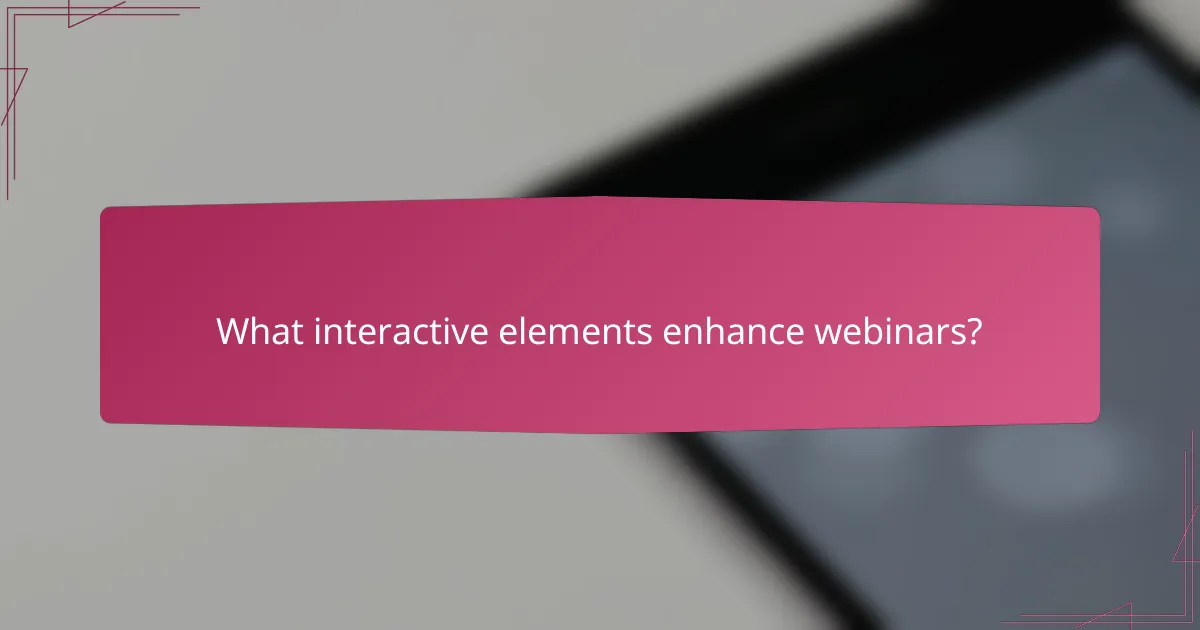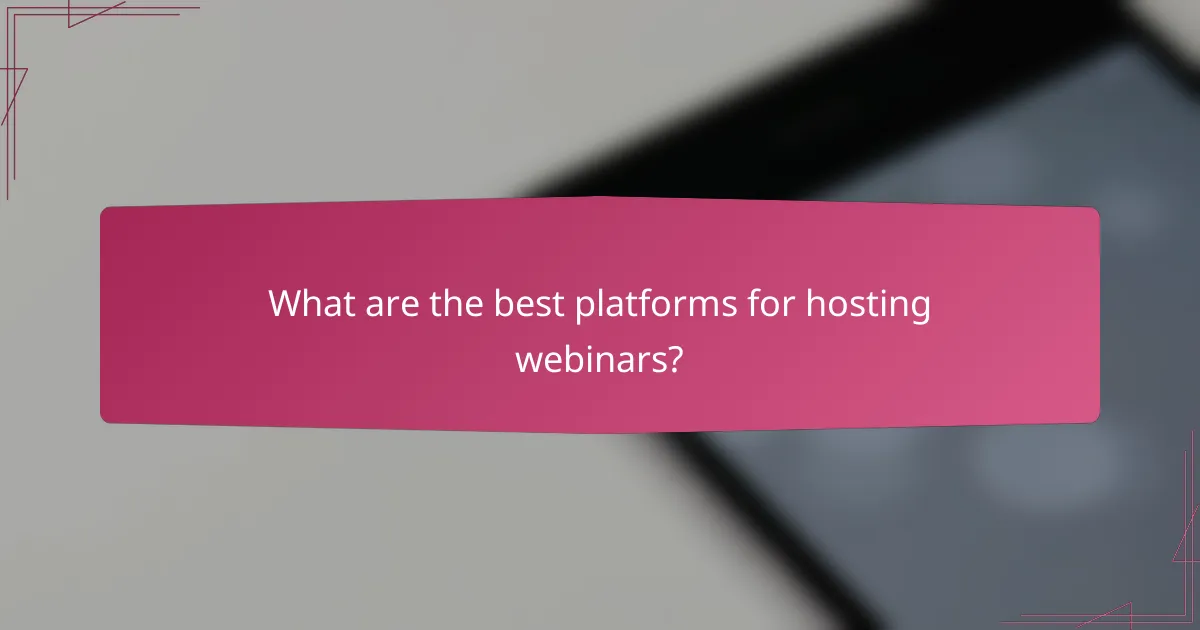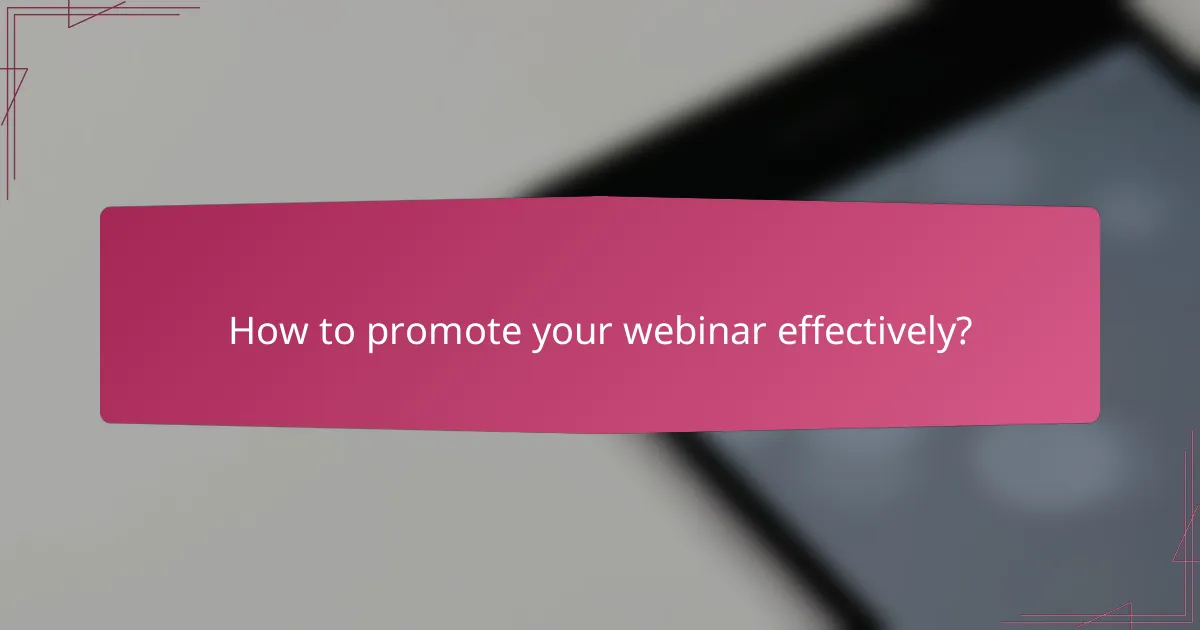Choosing the right topic for your webinar is essential to capture your audience’s interest and encourage participation. A skilled presenter can elevate the experience by delivering valuable insights while fostering interaction. By incorporating interactive elements like live Q&A sessions and polls, you can create a dynamic environment that enhances engagement and satisfaction among attendees.

How to choose a webinar topic for your audience?
Selecting a webinar topic that resonates with your audience is crucial for engagement and participation. Focus on their interests, challenges, and current trends to ensure the content is relevant and valuable.
Identify audience pain points
Understanding your audience’s pain points is essential for choosing a compelling webinar topic. Conduct surveys or interviews to gather insights on their challenges and frustrations. For example, if your audience struggles with time management, a webinar on productivity strategies would be highly relevant.
Consider creating a list of common issues faced by your target demographic. This can help you prioritize topics that will attract the most interest and participation.
Analyze trending industry topics
Stay informed about the latest trends in your industry to select a timely and engaging webinar topic. Follow industry news, blogs, and social media channels to identify what topics are currently capturing attention. For instance, if sustainability is trending, a webinar on eco-friendly practices could draw significant interest.
Utilize tools like Google Trends or social media analytics to gauge the popularity of specific topics over time. This data can guide your decision-making process and help you stay relevant.
Leverage customer feedback
Customer feedback is a valuable resource for determining what topics will resonate with your audience. Analyze comments, questions, and suggestions from past webinars or customer interactions to identify areas of interest. For example, if attendees frequently ask about a particular subject, consider developing a webinar focused on that theme.
Implement a feedback loop by encouraging participants to suggest topics for future webinars. This not only engages your audience but also ensures that you are addressing their needs and preferences directly.

Who are the best presenters for webinars?
The best presenters for webinars are those who can effectively engage the audience while delivering valuable content. Key characteristics include expertise in their field, a strong presence, and the ability to foster interaction.
Industry experts
Industry experts bring a wealth of knowledge and real-world experience to webinars. They can provide insights into current trends, best practices, and case studies that resonate with the audience. Selecting presenters with recognized credentials or significant achievements in their field enhances credibility.
When choosing industry experts, consider their ability to simplify complex topics and relate them to the audience’s needs. Look for professionals who have a track record of speaking at conferences or contributing to reputable publications.
Influential thought leaders
Influential thought leaders are individuals who shape opinions and drive discussions within their industry. They often have a strong online presence and a following that can enhance the visibility of the webinar. Their unique perspectives can inspire and motivate attendees.
To identify thought leaders, research those who frequently publish articles, host podcasts, or are active on social media platforms. Engaging these individuals can attract a larger audience and encourage participation through their established networks.
Engaging speakers
Engaging speakers are crucial for maintaining audience interest throughout the webinar. They possess strong communication skills, use storytelling techniques, and can create a dynamic atmosphere that encourages interaction. Their ability to connect with the audience can significantly impact retention of the material presented.
When selecting engaging speakers, assess their previous presentations and audience feedback. Look for individuals who can incorporate humor, visuals, and interactive elements like polls or Q&A sessions to keep the audience involved.

What interactive elements enhance webinars?
Interactive elements significantly enhance webinars by engaging participants and fostering a dynamic learning environment. Incorporating features such as live Q&A sessions, polls, and breakout rooms can lead to increased participation and satisfaction among attendees.
Live Q&A sessions
Live Q&A sessions allow participants to ask questions in real-time, creating a more interactive experience. This format encourages engagement and provides immediate clarification on topics discussed during the webinar.
To effectively implement a live Q&A, allocate specific time slots during the webinar for questions. Consider using a moderator to filter and prioritize questions, ensuring that the most relevant inquiries are addressed.
Polls and surveys
Polls and surveys are effective tools for gauging audience opinions and understanding their knowledge levels. These interactive elements can be used to gather feedback on the content or to assess participants’ understanding of key concepts.
When designing polls, keep questions concise and relevant to the topic. Aim for a mix of multiple-choice and open-ended questions to capture a range of responses. Use the results to tailor the discussion or address common misconceptions.
Breakout rooms
Breakout rooms facilitate smaller group discussions, allowing participants to collaborate and share insights in a more intimate setting. This format can enhance learning by encouraging peer-to-peer interaction and deeper exploration of topics.
To maximize the effectiveness of breakout rooms, provide clear instructions and objectives for each group. Limit the size of each room to foster meaningful conversations, and consider assigning a facilitator to guide discussions and report back to the larger group.

What are the best platforms for hosting webinars?
The best platforms for hosting webinars include Zoom, Webex, and GoToWebinar, each offering unique features and capabilities. Choosing the right one depends on your specific needs, such as audience size, interactivity options, and integration with other tools.
Zoom
Zoom is widely recognized for its user-friendly interface and robust features, making it a popular choice for webinars. It supports large audiences, with capabilities for hundreds to thousands of participants, and offers features like breakout rooms for smaller discussions.
When using Zoom for webinars, consider its integration with various applications, which can enhance your presentation. However, be mindful of potential security issues and ensure you enable necessary settings to protect your session.
Webex
Webex is another strong contender, particularly for businesses that prioritize security and compliance. It provides high-quality video and audio, along with features such as polls and Q&A sessions to engage participants effectively.
Webex is suitable for larger organizations, as it can accommodate significant attendee numbers. However, users may find the interface less intuitive compared to Zoom, so investing time in familiarization is advisable.
GoToWebinar
GoToWebinar is designed specifically for hosting webinars, offering features like automated email reminders and detailed analytics post-event. This platform is ideal for marketers and educators looking to track engagement and participant behavior.
While GoToWebinar supports a decent number of attendees, it may not be as flexible as Zoom or Webex in terms of interactive features. Ensure you leverage its analytics tools to refine future webinars based on participant feedback and engagement metrics.

How to promote your webinar effectively?
To promote your webinar effectively, leverage multiple channels to reach your target audience. A combination of social media, email campaigns, and influencer partnerships can significantly increase visibility and attendance.
Social media marketing
Social media platforms are powerful tools for promoting webinars. Create engaging posts that highlight key topics, the presenter’s credentials, and the benefits of attending. Use eye-catching visuals and relevant hashtags to expand your reach.
Consider running targeted ads on platforms like Facebook, Instagram, or LinkedIn to attract specific demographics. Allocate a budget that aligns with your expected audience size, typically ranging from a few hundred to several thousand dollars, depending on your goals.
Email campaigns
Email marketing remains one of the most effective ways to promote webinars. Craft a compelling invitation that includes essential details such as the date, time, and registration link. Personalize your emails to improve engagement rates.
Send reminder emails as the event approaches, ideally one week and one day before the webinar. A/B testing subject lines and content can help identify what resonates best with your audience, increasing open and registration rates.
Partnerships with influencers
Collaborating with influencers can amplify your webinar’s reach. Identify influencers in your niche who have a strong following and align with your webinar’s theme. They can promote your event through their channels, providing credibility and attracting their audience.
Offer incentives for influencers, such as a commission for each registration or exclusive access to the webinar. This mutually beneficial arrangement can enhance visibility and drive higher attendance rates.
